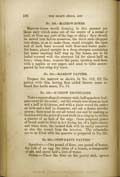Ingredients:—One pound of flour, one pound of butter, the yolk of an egg, the juice of a lemon, a teaspoonful of salt, and about half a pint of water.
Process:—Place the flour on the pastry slab, spread it out in the centre so as to form a well, in which place the salt, a small bit of butter, the yolk of egg, the lemon-juice, and two-thirds of the water required to mix the paste; you now spread out the fingers of the right hand and mix the ingredients together gradually with the tips of the fingers, adding a little more water, if necessary; when the whole is thoroughly incorporated together, sprinkle a few drops of water on it, and work the sponge to and fro on the slab for two minutes, after which the paste should be elastic—soft and smooth as satin—to the touch.
The paste thus far prepared must now be spread out with the bent knuckles of the right hand on the slab; and having pressed the butter in a cloth to extract any milk it may contain, place it in the centre of the paste, and partially spread it by pressing on it with a cloth; the four sides should then be folded over so as entirely to cover the butter; shake a little flour over and under it; shape the paste in a square form measuring about ten inches each way; place this on a baking-sheet on the ice, and a sautapan filled with rough ice set upon the paste to keep it cool and firm
About ten minutes after the paste has been thus far prepared, roll it out on the slab with a rolling-pin, and shaking some flour lightly and sparingly over and under the paste to prevent it from sticking either to the rolling-pin or slab, and having rolled the paste out to exactly thirty inches in length, fold it in three equal folds; press these together by running the rolling-pin over the paste; turn it round and roll it out again the reverse way, in the same manner and length as before; fold it in three equally; fasten these folds by running the rolling-pin over them with pressure, and set the paste back on the ice to rest for eight or ten minutes; at the end of this time give two other turns as just described, and having again rested for other ten minntes, it must receive two or three more turns previously to its being cut out for baking.
The next thing to be done is, when after the last turn has been given to the paste, and it has been rolled out to the thickness of the sixth of an inch, and has been allowed to rest upon the ice for about three minutes, with a plain or fluted round tin patty cutter, just dipped in hot water, stamp out as many patties as you require; place these on a baking-sheet previously moistened over with a brush dipped in water; press each down in its place with the fingers, egg over their surfaces, and with another plain tin round cutter less in diameter than the one with which the patties have been stamped out— this also dipped in very hot water,—make a circular incision in the centre of the patty; push the sheet in a rather brisk oven, and bake them for about twenty minutes; and when done, it will be an easy matter to remove the tops and the crumb from the interior with a small-pointed root knife.
Note.—The use of rough ice in making puff paste is absolutely necessary during the summer months only; during cold weather it may be dispensed with.
The patties being made according to the foregoing directions, are to be filled just before going to table with any of the different kinds of minces of poultry, game, or other meats, as also with all sorts of shell and other fish, prepared as in Nos. 315, 317, 318, and 321.
